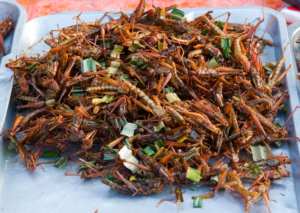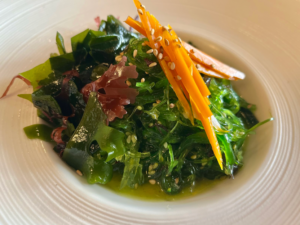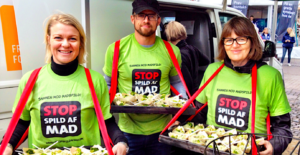Empty Shelves © Michael Kwok

Food is one of the most important and basic needs of every living being.
Abraham Maslow, an American psychologist, developed the idea of a hierarchy of needs in 1943. He explained his ideas in ‘A Theory of Human Motivation’ and created a ‘pyramid of needs’ ordered by importance, with the most basic needs of the individual, physiological needs such as food, air and clothing, at the bottom and the needs for security, love and belonging as well as esteem and self-actualisation at a higher level of the pyramid.
He emphasised the idea that the needs further down the hierarchy must be met before the individual can address the needs higher up.
But the human population is still growing rapidly and the earth’s resources seem to be limited. What will we do if one day we reach the limits and it is no longer possible for us to feed everyone as we do today? Furthermore, current agricultural, fishing and industrial practices are having a negative impact on nature and the way we feed ourselves needs to become much more sustainable. What then?…
These are questions that have troubled people for many years. Scientists, politicians and governments are trying to answer these questions and create action plans to avoid a severe food crisis that would inevitably lead to riots and catastrophes, to a collapse of humanity.
The current situation with the war in Ukraine leading to grain shortages in many poor countries has given us a taste of what could happen later on a larger scale. In 2022, the reasons for hunger and food insecurity vary from country to country, mostly as a result of armed conflict, poverty, economic and environmental shocks.
But sooner or later we may all suffer from food shortages, and what is simple and readily available today may be just a memory in the not too distant future
There are voices that estimate that the world will probably run out of food as early as 2050 (www.theworldcounts.com). Personally, I think this is a bit too pessimistic, but it is logical that you cannot feed more and more people with traditional limited supplies. They also say that we would need 1.8 planets to feed us in the future… and we do not have that.
Some experts say that one of the possible solutions could be for the entire human population to become vegetarians. Meat is now considered a highly inefficient source of food. It is very expensive to produce (especially beef), requires a large amount of energy and resources, and is also harmful to the climate.

Apart from the spiritual reasons some vegetarians cite when advocating this cause, there seems to be an economic and more practical reason to turn to vegetarianism. This trend has been going on for years. There are now many more vegetarian and vegan food alternatives available in supermarkets, and at very reasonable prices too. There are already many restaurants offering meat-free menus, and even the landmark McDonalds now has a vegetarian alternative to its famous burgers. Thousands of books explain the potential benefits of a low-meat or meatless diet… all to persuade people around the globe to change their ancestral eating habits.
But would that be a real solution?
According to American biologist, naturalist, and writer Edward Wilson “If all people agreed to eat a vegetarian diet, leaving little or nothing for animals, about 10 billion people could live on the current 1.4 billion hectares of arable land. There is little room for flexibility, the constraints of the biosphere are fixed”.
However, despite these extensive campaigns to raise awareness and popularise vegetarian and vegan diets, it is unlikely that the entire world population will unanimously and voluntarily adopt this lifestyle. In the Western world, this is even less likely. If we look only at American dietary habits, we quickly realise this.

So, instead of convincing everyone to stop eating meat, we should seriously and sustainably look for other alternatives to meat and current conventional foods.
Scientists have been studying this for a while. The aim is to reduce the total amount of animal products eaten by humans and replace them with delicious plant-based alternatives to minimise the impact of the human diet on the planet.
But scientists and nutritionists now say that eating alternative “foods of the future” such as lab-grown meat, algae and even insects would protect the planet and provide food for a growing population, but also provide better nutrients and high-quality protein than an exclusively plant-based diet.
Apart from the fact that the extraction of these future foods requires far less land and energy and produces far fewer greenhouse gases than animal or even plant foods, lab-grown meat, proteins from mushrooms, fly larvae, some types of algae and mussels actually provide the same amount or more protein than animal or plant foods.
In addition, this alternative food contains several other nutrients that are considered crucial for a balanced and healthy diet, such as zinc, vitamin A and vitamin B12. For example, some algae contain 20 times more vitamin A than eggs. In comparison, vegan diets are usually deficient in vitamin B12 and Omega fatty acids, leading to major imbalances over time.
Laboratory-grown meat has already been successfully obtained from cells of animal origin. Over several weeks, the cells in the laboratory are provided with nutrients and certain growth factors, so that they develop into a normal piece of meat that can then be cooked, roasted or grilled like any other type of meat. Most importantly, it smells, tastes and looks the same and contains the same amount of important nutrients, so it has no disadvantages for human nutrition. It is not yet on sale in supermarkets, but some start-ups are already promoting it.

World Food Day (WFD) is celebrated on October 16, 2022. The day is observed every year around the world on 16 October in honor of the date of the founding of the Food and Agriculture Organization of the United Nations in 1945 © Fao
The production of such foods of the future is still a new and emerging industry. However, it is expected to be receptive to major changes towards sustainability. While traditional agriculture is considered a major cause of climate change, alternative and energy-efficient meats could help meet the needs of a growing global population.
The consumption of insects (over 1,900 edible species) has long been common, especially in Asia. Fried crickets or roasted worms are the norm in many restaurants in Thailand, but also in Mexico. The trend is now also making its way into the Western diet as an environmentally friendly protein alternative.
I remember seeing fried insect dishes and also insect bars in the supermarket at a World Food Congress in Berlin a few years ago. It is not clear how successful these new trends are, but it is a fact that we are all moving in this direction. Insect farming can successfully compete with animal farming. It requires less land, water and energy for mass production and releases fewer greenhouse gases into the atmosphere. At the same time, insect production could help reduce food waste, as insects can be fed with unwanted fruits and vegetables.

Theworldcounts.com estimates that we have about 25 years until the end of natural seafood. Considering that much of it is already contaminated with microplastics, it is clear that we need to find a way to prevent this and find alternatives.
Aquaculture is one of them. Scientists have studied many species of fish and selected some, such as pangasius or tilapia, that grow quickly and do not have problems with crowded habitats, so they are cheap to produce. In some parts of the world, people are already used to these fish species, which are becoming more and more popular.
Seafood is another great way to eat in an environmentally friendly way as it has a much smaller carbon footprint. They are considered healthier than animal meat and are a rich source of protein and macronutrients that cannot be obtained elsewhere. Nutritionists also say that jellyfish could be another future nutritional solution. The 25 edible species of jellyfish are low in calories and fat, but rich in protein and antioxidants, and are already consumed in some Asian countries such as Thailand, Malaysia and Japan.
While an estimated one-third of the world’s agricultural soils are already degraded, experts are looking for alternatives and see marine plants as an important future food source.
Seaweed is one of them. Today, there are about 10 000 different species of seaweed, of which the best known is probably nori (the dried leaves that are wrapped around sushi). They are used in many delicious dishes such as soups, stews, salads and even cakes or smoothies.

Cactus plants are also considered a future alternative for a plant-based diet because they are rich in fibre and micronutrients. They grow in dry regions and do not require careful maintenance. There are over 1,500 species of cactus, many of which are edible. They are already consumed in Latin America, used in fruit juices or grilled and served with eggs or in salads and tacos. Together with other cereals and pseudocereals such as quinoa or amaranth, they have become increasingly popular, especially in recent decades. In many countries, they can now be found in organic food shops.
Nowadays there is a trend towards a plant-based diet to reduce the consumption of animal products. Plant-based meat looks and tastes like meat, but is made from plants.
Soy is usually the main ingredient in plant-based foods. It is rich in protein and comes in many forms such as tofu, edamame beans or tempeh. However, it is not recommended for everyone as it can affect thyroid function, especially in women.
Eating lentils, chickpeas, beans, nuts and seeds is also recommended by nutritionists if you choose a plant-based diet.
In addition to all these dietary changes, one important action we can all take to combat climate change and prevent world hunger and food shortages is to stop wasting food.
It is estimated that more than 891 million tonnes of food are wasted worldwide every year! About one third of the world’s food is lost or wasted. More greenhouse gases are emitted through food waste than in all countries in the world except China and the USA.
Food is lost or wasted all along the food supply chain, from the production stage, through processing and manufacturing, to supermarkets, restaurants or at home. Food ‘waste’ refers to food that is fit for consumption but is deliberately thrown away at retail or consumption.

In the EU region alone, around 88 million tonnes of food are wasted every year. This corresponds to 174 kg per person, 143 billion euros or 170 000 000 tonnes of CO2. (Source: https://www.eufic.org ) The extent of food waste is similar in high, upper and lower middle income countries across Europe.
The EU Commission supports the exchange of best practices on food waste prevention through the EU Platform on Food Loss and Food Waste. The Commission plans to propose legally binding targets to reduce food waste in the EU by the end of 2023. The Waste Framework Directive is expected to propose measures to reduce food waste and increase preparation for reuse or recycling of waste. Some European countries have already enacted internal legislation to prevent food waste. In February 2016, France passed a law to combat food waste that prohibits supermarkets from destroying unsold food and instead requires them to donate it.
Due to its strict food waste prevention policies, sustainable farming practices and also healthy eating habits, France is now ranked first in the Food Sustainability Index, a study by The Economist Intelligence Unit and the Barilla Centre for Food & Nutrition Foundation that looks at 34 countries. Every morning, more than 2,700 French supermarkets send nearly expired food to more than 80 warehouses across the country, saving 46,000 tonnes of food each year.
In Norway, there are now special supermarkets dedicated exclusively to the sale of nearly expired food. There are also numerous platforms where people can learn more about how to use food efficiently. The country wants to halve its food waste by 2030. Germany now has the same goal. (In Germany, about 11 million tonnes of food are thrown away every year).
Denmark now has the most food waste initiatives in Europe. Thanks to the active and effective campaigns of a non-profit organisation called Stop Food Waste (“Stop Spild Af Mad” is the original Danish name), the population has significantly changed its consumption habits, with very visible results.

Worldwide, Japan and South Korea are pioneers in the fight against food waste.
But we can all do something about it. Eating healthier and more sustainably, planning our meals more carefully, shopping responsibly and moderately, organising our fridge and storing food properly, learning new cooking skills, composting and recycling food waste or donating food are just some of the simple ways we can all contribute to a greater cause.
And what could be more important than saving the future of our home, planet Earth?

